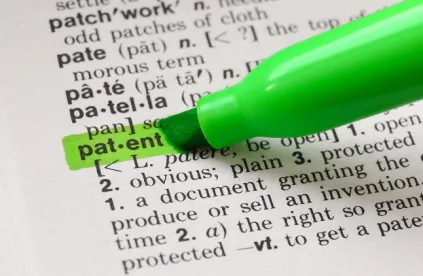AbbVie’s arguments raised in a prior IPR were key to the PTAB’s finding of no commercial success.
The Patent Trial and Appeal Board (PTAB) found all of the claims of three AbbVie Biotechnology Ltd. (AbbVie) patents directed to Humira unpatentable in the last month as a result of three inter partes reviews (IPRs) requested by Coherus Biosciences Inc. (Coherus). On May 16, 2017 the PTAB issued a Final Written Decision finding all of the claims (1–5) of US Patent No. 8,889,135 (the ’135 Patent) unpatentable. Subsequently, the PTAB issued two Final Written Decisions on June 9, 2017 finding claims 1–4 of US Patent No. 9,017,680 (the ’680 Patent) and claims 1 and 2 of US Patent No. 9,073,987 (the ’987 Patent) unpatentable.
The PTAB rejected all of AbbVie’s secondary considerations of nonobviousness, including commercial success; long-felt, unmet need; and unexpected results. Notably, the PTAB rejected AbbVie’s assertion that the commercial success of Humira supported the nonobviousness of the claimed invention in part because of statements made by AbbVie in other IPRs challenging patents in the Humira portfolio.[1] Here the PTAB found that AbbVie previously relied on features other than those recited in the ’135, ’680, and ’987 Patents as driving Humira’s commercial success.
US Patent No. 8,889,135
The ’135 Patent, “Methods of Administering Anti-TNFα Antibodies,” issued on November 18, 2014, and is directed to methods of treating rheumatoid arthritis with human anti-tumor necrosis factor α (TNFα) antibody. In particular, the patent claims methods involving subcutaneously administering an anti-TNFα antibody with the same six complementarity-determining regions (CDRs) and heavy chain constant region as D2E7 (i.e., Humira) at a dose of 40 mg once every 13–15 days.
Background
On November 9, 2015 Coherus filed an IPR petition for the ’135 Patent, which the PTAB instituted on May 17, 2016, to determine whether all of the patent’s claims, 1–5, were obvious in view of two references: Kempeni and van de Putte. The PTAB’s Final Written Decision issued just a day short of one year after institution.
In its petition Coherus argued that Kempeni and van de Putte rendered claims 1–5 of the ’135 Patent obvious.[2] Briefly, Coherus argued that Kempeni disclosed that Humira that is intravenously administered biweekly including at a dose of 40 mg has an estimated half-life of 11.6 to 13.7 days. Further, Coherus argued that van de Putte disclosed administering Humira subcutaneously. Thus, Coherus argued that the combination of both references taught each and every element of the claimed invention. Ultimately, the PTAB agreed with Coherus and found that a person of ordinary skill in the art would have been motivated to combine Kempeni and van de Putte to achieve subcutaneous administration of Humira at a dose of 40 mg because such administration would be more desirable for patients (i.e., less expensive and more convenient). AbbVie, on the other hand, argued that a person of ordinary skill in the art would not have been motivated to develop a 40 mg, subcutaneous, every-other-week dosage regimen to treat rheumatoid arthritis, and would not have had a reasonable expectation of success in treating rheumatoid arthritis using such a dosing regimen in view of the prior art’s teachings.[3]
PTAB’s Analysis
The PTAB found that Kempeni teaches that D2E7 is safe and effective as a monotherapy when administered subcutaneously or intravenously by single or multiple injections.[4] Further, the PTAB found that van de Putte teaches that doses of D2E7 were superior to a placebo and that 20, 40, and 80 mg/week dosages were almost equally efficacious when administered subcutaneously to patients with rheumatoid arthritis.[5] Based on these references’ disclosures, the PTAB found that together Kempeni and van de Putte disclose or suggest each element of claims 1–5.[6]
The PTAB characterized the parties’ disputes regarding motivation to combine and reasonable expectation of success as “hotly” contested.[7] Ultimately, the PTAB sided with Coherus and found that a person of ordinary skill in the art would have had a reason to select a subcutaneous administration route and fixed dosing regimen with a reasonable expectation of success.[8]
With respect to biweekly administration of a 40 mg dose, the PTAB was not persuaded by Coherus’s argument that a person of ordinary skill in the art would have done so based on the disclosed half-life of D2E7.[9] In particular, the PTAB noted that Coherus never provided evidence of a drug with a dosing interval that corresponded to its half-life or other evidence showing that persons of ordinary skill in the art routinely use half-lives to create dosing schedules, and AbbVie provided evidence to the contrary.[10]However, the PTAB found persuasive Coherus’s argument that the disclosure of administration of 0.5 mg/kg of D2E7 biweekly, which is equivalent to a 40 mg subcutaneous dose, would provide a motivation to combine with a reasonable expectation of success.[11] Specifically, the PTAB found that “Kempeni expressly discloses a dose that is equivalent to the recited subcutaneous 40 mg dose” and also teaches biweekly administration.[12]
Additionally, the PTAB found that the record showed that a person of ordinary skill in the art either would have used a clinical approach to design a dosing regimen involving testing different doses and dosing intervals, which AbbVie did for D2E7, or would have used a theoretical model approach.[13] AbbVie’s expert admitted that the publicly available pharmacokinetic information in June 2001 would not have allowed a pharmacokinetic/pharmacodynamic correlation for modeling purposes because it did not include patient-specific data.[14] Nonetheless, he performed a modeling exercise, to which the PTAB afforded little weight, in part because the minimum effective dose of D2E7 was undefined in June 2001.[15]
Further, the PTAB found that the potential to develop anti-drug antibodies would not have discouraged a person of ordinary skill in the art from pursuing the claimed 40 mg biweekly dosing regimen.[16] Specifically, Kempeni discloses that one would expect the fully human D2E7 to be less immunogenic than other antibodies that contain nonhuman portions.[17] Moreover, the PTAB did not find sufficient evidence to show that fluctuations in the minimum and maximum steady state plasma concentrations for a 40 mg biweekly treatment would have raised sufficient safety issues to discourage use of such a dosing regimen.[18]
AbbVie further argued that there was evidence of a long-felt, unmet need; unexpected results; and commercial success supporting a finding of nonobviousness.[19] In particular, AbbVie heavily relied on Humira’s dosing regimen as driving its commercial success. In response, Coherus pointed to AbbVie’s argument in a related IPR that the commercial success of Humira
was driven in large part by (i) the ability of patients to self-administer a liquid antibody formulation via single dose subcutaneous administration . . . without lyophilization and the accompanying need for reconstitution, and (ii) the fact that it is stable enough to be commercially viable (e.g., to withstand shipping and storage for periods of time typical or biologic therapies).[20]
AbbVie failed to mention that the dosing regimen was responsible for the commercial success of Humira. As such, the PTAB found that it was not clear whether the sales of Humira were due to the claimed dosing regimen or the formulation that AbbVie argued was the driver of commercial success in the related IPR. Consequently, the PTAB was not persuaded by AbbVie’s evidence of commercial success.[21]
Similarly, the PTAB was not persuaded that the claimed dosing regimen satisfied a long-felt, unmet need.[22] The PTAB concluded that the prior art disclosed biweekly dosing regimens and subcutaneous dosing of anti-TNFα agents.[23] Further, the PTAB found that AbbVie failed to tie its supporting evidence to the claimed 40 mg dose[24] and failed to sufficiently connect its success, in view of others’ failures, to a biweekly subcutaneous dose.[25] Instead, the PTAB concluded that the “driving force behind the satisfaction of a long-felt need and success where other[s] had failed was the introduction of the first fully human anti-TNFα antibody, not the claimed dosing regimen.”[26] Likewise, the PTAB rejected AbbVie’s arguments regarding unexpected results.[27] According to the PTAB, AbbVie merely reiterated its teaching-away arguments, which were found unpersuasive for the reasons discussed above.[28]
In view of the foregoing, the PTAB concluded that Coherus demonstrated by a preponderance of the evidence that claims 1–5 of the ’135 Patent were obvious over the combination of Kempeni and van de Putte.[29]
US Patent No. 9,017,680 and US Patent No. 9,073,987
The ’680 Patent, “Methods of Administering Anti-TNFα Antibodies,” issued on April 28, 2015, and, like the ’135 Patent, is directed to methods of treating rheumatoid arthritis with human anti-TNFα antibody (i.e., a method involving administering 40 mg of anti-TNFα antibody once every 13–15 days with methotrexate where the anti-TNFα antibody has the same six CDRs and heavy chain constant regions as D2E7); and the ’987 Patent, “Methods of Administering Anti-TNFα Antibodies,” issued on July 7, 2015, and is directed to methods of treating rheumatoid arthritis by subcutaneously administering a 40 mg dose of human anti-TNFα antibody once every 13–15 days (where the anti-TNFα antibody has specific CDRs, variable light chain regions, and variable heavy chain regions).
Background
On December 7, 2015, Coherus filed IPR petitions for the ’680 Patent and the ’987 Patent. Both were instituted on June 13, 2016. The ’680 Patent IPR was instituted to determine whether all of the patent’s claims, 1–4, were obvious in view of Kempeni and van de Putte, and the ’987 Patent IPR was instituted to determine whether all of the patent’s claims, 1–2, were obvious in view of the same references, which were also the same references asserted against the ’135 Patent.
In its petitions, Coherus argued that van de Putte and Kempeni rendered claims 1–4 of the ’680 Patent and claims 1–2 of the ’987 Patent obvious.[30] As with the ’135 Patent’s IPR, AbbVie argued that a person of ordinary skill in the art would not have been motivated to develop a 40 mg, subcutaneous, every-other-week dosing regimen to treat rheumatoid arthritis, and would have no reasonable expectation of success in doing so.[31]
PTAB’s Analysis
The PTAB made the same findings regarding Kempeni’s and van de Putte’s disclosures as discussed above with respect to the ’135 Patent’s IPR.[32] For similar reasons, the PTAB concluded that Kempeni and van de Putte together disclose every element of claims 1–4 of the ’680 Patent and claims 1–2 of the ’987 Patent.[33]
Similar to the ’135 Patent’s IPR, Coherus argued that a person of ordinary skill in the art would have been led to administer 40 mg of D2E7 subcutaneously every 13–15 days in combination with methotrexate, as claimed in the ’680 Patent, and would have expected it to be safe and effective in treating rheumatoid arthritis.[34] The parties’ arguments largely mirrored those in the ’987 Patent IPR.[35]
In view of the foregoing, the PTAB concluded that Coherus demonstrated by a preponderance of the evidence that claims 1–4 of the ’680 Patent and claims 1–2 of the ’987 Patent were obvious over the combination of Kempeni and van de Putte.[36]
[1] See IPR2016-01018 regarding US Patent No. 9,114,166.
[2] Final Written Decision at p. 10.
[3] Id.
[4] Id. at p. 12.
[5] Id. at p. 13.
[6] Id. at pp. 14-15.
[7] Id. at p. 16.
[8] Id. at pp. 16-17.
[9] Id. at p. 18.
[10] Id. at p. 22.
[11] Id. at pp. 18, 24.
[12] Id. at p. 25.
[13] Id. at p. 33.
[14] Id.
[15] Id.
[16] Id.
[17] Id. at pp. 33-34.
[18] Id. at p. 35.
[19] Id. at p. 38.
[20] Id. at pp. 39-40.
[21] Id.
[22] Id. at pp. 42-43.
[23] Id. at p. 42.
[24] Id.
[25] Id.
[26] Id.
[27] Id. at p. 43.
[28] Id.
[29] Id. at p. 44.
[30] ’680 Patent Final Written Decision at p. 10; ’987 Patent Final Written Decision at p. 9.
[31] Id.
[32] Id. at pp. 10-14.
[33] Id. at p. 15.
[34] Id. at p. 16.
[35] Id. at pp. 16-17.
[36] ’680 Patent Final Written Decision at p. 44; ’987 Patent Final Written Decision of p. 42.




 />i
/>i

